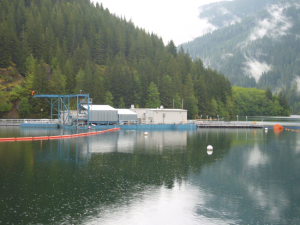Post
A Model for Innovative Fish Passage
Fishing Conservation, Freshwater Fishing Articles, Salmon, Steelhead & Trout theangler PM

Salmon and steelhead travel between freshwater rivers and the Pacific Ocean as part of their life cycle. In northwest Washington’s Baker River, a tributary to the Skagit River, salmon and steelhead face several challenges on their journey to the sea. These include the loss of critical habitat, poor water quality, and predation. Their biggest challenge, however, is the barrier created by two large hydroelectric dams. The Lower and Upper Baker Dams, owned and operated by Puget Sound Energy, power approximately 60,000 northwest Washington homes annually, but they also block natural fish passage on the Baker River. To facilitate fish passage, NOAA Fisheries engineers worked closely with Puget Sound Energy to design an innovative fish passage system, known as the floating surface collector.
The collector is a 130-foot by 60-foot barge that is moored in Baker Lake, upstream of the Upper Baker Dam. Soft guide nets extend out to each side of the lake, from top to bottom, leading migrating juvenile salmon into the facility. Once there, fish are held in specially designed tanks and transferred to an evaluation station where scientists collect information and data on collection effectiveness, migration size and composition, and fish health. After evaluation, fish are transported by tank trucks below the lower dam and held for a brief period in stress-relief ponds before continuing their seaward journey. Upstream migrating adults are diverted into a trap facility downstream from the lower dam and transported via tanker truck upstream of the dams to spawn.
NOAA Fisheries is responsible for ensuring that hydroelectric facilities do not compromise the survival and recovery of listed species. Puget Sound Chinook, coho, and steelhead migrate through this area and are protected under the Endangered Species Act; Chinook and steelhead are both listed as threatened species, while coho salmon is identified as a species of concern. NOAA Fisheries is evaluating the effectiveness of the floating surface collector to ensure that the biological needs of migrating salmon and steelhead are met. Results indicate that the new collector design is benefiting migrating fish.
Earlier versions of the collector, known as gulpers, have been used at the dams since the 1960s, but these models were smaller and less effective at attracting large numbers of salmon and steelhead. One unique characteristic of the new collector is its ability to adjust to variations in water levels behind the dam, known as forebay fluctuations. The Upper Baker forebay is capable of fluctuating as much as 50 feet. The new structure accounts for this fluctuation and makes the transition from the net into the collector much smoother for the fish by allowing them to follow surface currents. In the five years that the Upper Baker floating surface collector has been in place, the number of adult fish returning to spawn has increased dramatically. In 1985 only 99 adults returned to the Baker River, but 2012 has seen an all-time high of more than 47,000 returning salmon. The total number of juvenile fish migrating downstream in 2012 also set a new record—approximately 540,000 juvenile salmon and steelhead were collected and transported downstream. A similar collector on the Lower Baker Dam was just launched and will begin operations in spring 2013.
The new design exemplifies the next generation of fish passage technology and is one of the preeminent models now used in fish passage projects. By working together with our partners and stakeholders on projects such as the floating surface collector, NOAA Fisheries is advancing the recovery of listed salmon and steelhead species through innovative fish passage engineering.
